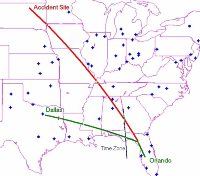@
hellogoodbye With radar, though, it's somewhat complicated. There are two types of radar - "regular" radar that's been around since WWII that actually picks up "echos" bouncing off of objects (e.g. a plane), and "modern" radar that works together with equipment (i.e. the transponder) on board each aircraft. The aircraft originally disappeared off the newer radar system, so basically the transponder shut off. Military radar could still pick it up since it's of the older type, but the various countries that detected it on that radar didn't want to tell anyone because they didn't want the world to know how good their radar is. Slowly information is coming in from those countries, as well as info from the engines (transmitted via satellite). It all points to hijackers purposefully turning off various communications systems, then flying to points unknown.
Unfortunately the ATC system is fairly antiquated. The radar systems in use today are basically what you said, the echos bouncing off, and then the transponder is just a way to add information to a signal, such as altitude, speed, Aircraft type, call sign, and filed flight path (this is called a Mode C Transponder). The difference is literally a dot on a screen or a dot with an associated Data Tag.
I'm not familiar with the airspace down there, but a great example is flying over the Atlantic from New York to London-Heathrow. You hit a point where you are so far from land that you are no longer on any radar systems, and instead are being "tracked" by a flight service station. Basically you call in at specified waypoints and provide information relating to your altitude, latitude, longitude, current speed, and current heading to next waypoint. There is no radar here, just someone tracking aircraft based on information the pilot passes to the controller. The spot in where they lost communications is likely a similar area (just by looking at a map, seems likely). Once you disable your transponder, you still have that BLIP on a radar, if there is a radar, but none of the other information that a data tag would include.
No radar services means you could fly wherever you want until you hit controlled airspace, and then your "echo" would show up on radar again. At this point you can likely fudge the system by flying low enough that your surroundings interfere with the echo (hills, etc), or low enough in lighter-controlled airspace that you are below an ATC "floor". This floor is uncontrolled air space, and your ATC radar would have any data BELOW said point disabled on their scope to prevent unnecessary clutter from your average VFR traffic flying below controlled airspace.
Seems unlikely that they would actually get anywhere without anyone knowing they landed, or without SOMEONE seeing SOMETHING on a scope at one point or another. Even when flying below controlled airspace, there's likely a system somewhere that is pulling data and still tracking these blips, but you'd have to know what the blip is based on historical data from the rest of the flight (which gets lost when you don't know exactly where the aircraft started flying to outside of the initial uncontrolled airspace over the water).
Not sure how a noisy 777 would be able to fly under controlled airspace without someone hearing or seeing a plane flying in a manner that isn't typical of other traffic in the area. Being so far out from the aircraft's disappearance I'd have expected someone to come forward by now. Even IF the aircraft was somehow able to fly at a low enough altitude to slip under radar services, it seems unlikely that nobody would notice a 777 landing. You'd hear it, you'd feel it. You'd know something was wrong. It's one thing to fly a few thousand feet in the air below atc service, it's another to actually LAND an aircraft somewhere that doesn't get those types of planes. Seems likely it's at the bottom of an ocean somewhere.
That specific flightpath it was scheduled to fly would put it potentially in range of flying as far North west as Pakistan. It's about 2300 nautical miles. HOWEVER, you're not factoring in flying against the winds, or flying at a lower altitude resulting in more drag and faster fuel consumption. If it somehow isn't under the ocean and somehow happened to land somewhere, I doubt it would have made it more than 1000-1500 nautical miles from it's origin airport best case scenario.
Just seems unlikely, given the information that is publicly available, that it would have made it anywhere without at least some form of detection at one point or another, being radar, military radar, civilian detection (if it was indeed flying low), or otherwise.



